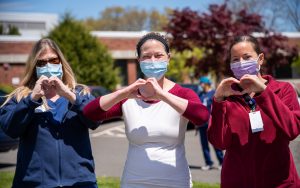TL;DR:
- School nurses ease the anxieties of staff, students, and families.
- There are many responsibilities beyond the obvious that school nurses have every single day.
- A school nurse shares some of the biggest changes and silver linings that have occurred over the past year.
Similar to teachers and administrators, I don’t think any school nurse envisioned what they’d be doing during a pandemic. As challenging as I know my job is right now, I don’t envy our school nurses. An enormous amount of responsibility was dumped on them seemingly overnight. Keeping up with the latest CDC guidelines alone, which have changed so much over the last year, is practically a full-time job itself! School nurses are providing key insights and valuable feedback to administrators regarding the health and safety of our school communities. Oftentimes they serve as a voice for the faculty and staff. But who is checking in on them?!
Kudos to ALL of our school nurses who are wearing many more hats (and masks) than ever before! They deserve all of our appreciation, not just on School Nurses Day, but every day! Share on XSchool Nurses: Easing Anxieties
My school is relatively small, and I’m fortunate to have a great relationship with our school nurse Pat Raphael, who has been with us for five years. When COVID shut down the world last spring, I spoke with her several times and remember her telling me how the district was already starting to plan for the fall.
Several staff members, including myself, were asking her to give us advice on all things virus-related. In true “nurse-like” fashion, Pat remained calm and a voice of reason in a time when we needed it most. And that is still true today, not only for the staff, but for the students and their families as well.

Photo credit: Rusty Watson via Unsplash
School Nurses: The Obvious vs. The Not-So-Obvious
There are the obvious job responsibilities I see Pat fulfilling each day: temperature checks, tracking down students who don’t show up for school, tracking down me when I don’t put in attendance on time (sorry Pat!), conducting contact tracing, analyzing symptoms, answering questions about the vaccines, etc.
But I always knew there were many more not-so-obvious job responsibilities she took on since COVID started, such as serving as an impromptu therapist when faculty, staff, or students needed to vent their anxieties or frustrations.
I decided to ask Pat herself a few questions related to school nursing during COVID. True to form, not only did she respond to me swiftly, but she took the time to answer thoughtfully.
School Nurses: Biggest Changes
Q: What are the most significant changes/impacts of being a school nurse during a pandemic, as opposed to before?
A: Obvious changes include the physical school environment—separated desks with plexiglass, thermometers, and hand sanitizing stations, students and staff in masks, no food served, quiet hallways (most of the time). The students initially appeared subdued, but gradually returned to their normal selves as they got used to the new environment. Some virtual learners returned to in-person after they saw their friends safe at school.
What was probably not so obvious, but understandable, was the palpable tension in the air, particularly at the start of the school year. I felt there were varying degrees of anxiety among the staff. How will this work? Am I safe here? Will my family stay safe once I get home?
Many of the students were probably experiencing varying degrees of anxiety as well. Initially, they were discouraged from popping into the health office for no reason. The health office was a ghost town the first couple of months!
After the students became more comfortable at school, they began trickling in, sometimes with the normal complaints such as skinned knees, stomach aches, and headaches. Once in the health office, the students would often talk about their fears, anxieties, boredom, and missing the freedom of seeing and playing with their friends and family members. In the past, the smallest of symptoms were taken care of quickly, with the students returning to class. This year those same symptoms prompt a long list of COVID-related questions.
[scroll down to keep reading] School Nurses: Silver Linings
School Nurses: Silver Linings
Q: If you can find any silver linings to this pandemic, as they relate to the school environment, what would they be?
A: There is a silver lining to this pandemic, and that is that in hardship, there often comes resilience and strength. Children are energetic, idealistic, and resourceful. They are experiencing upbeat, positive reinforcement from the staff at school; if there is heaviness at home, hopefully their school environment will help sustain them.
Families who remain positive and hopeful for their children are helping them become more resilient and confident. I have spent more time getting to know the families this year, and have had many great conversations. Parents are people too…with the same fears and anxieties that we all have! We hope this pandemic will become a learning experience that leads to a better and healthier life for us all.
Kudos to ALL of our school nurses who are wearing many more hats (and masks) than ever before! They deserve all of our appreciation, not just on School Nurses Day, but every day!
ABOUT BECKY THAL
Becky Thal is a 5th grade math and science teacher in New Jersey. In addition, she works on marketing projects for the Teach Better Team and is an edtech consultant. Prior to starting her career in teaching in 2005, Becky worked for several years in advertising in New York City. She is an active member of her school staff and local community. In her spare time, Becky enjoys trips to the beach, trying new restaurants, and attending her kids’ various sports games and events. She lives with her husband, three children, and Labradoodle, who she loves spending time with on the weekends.


